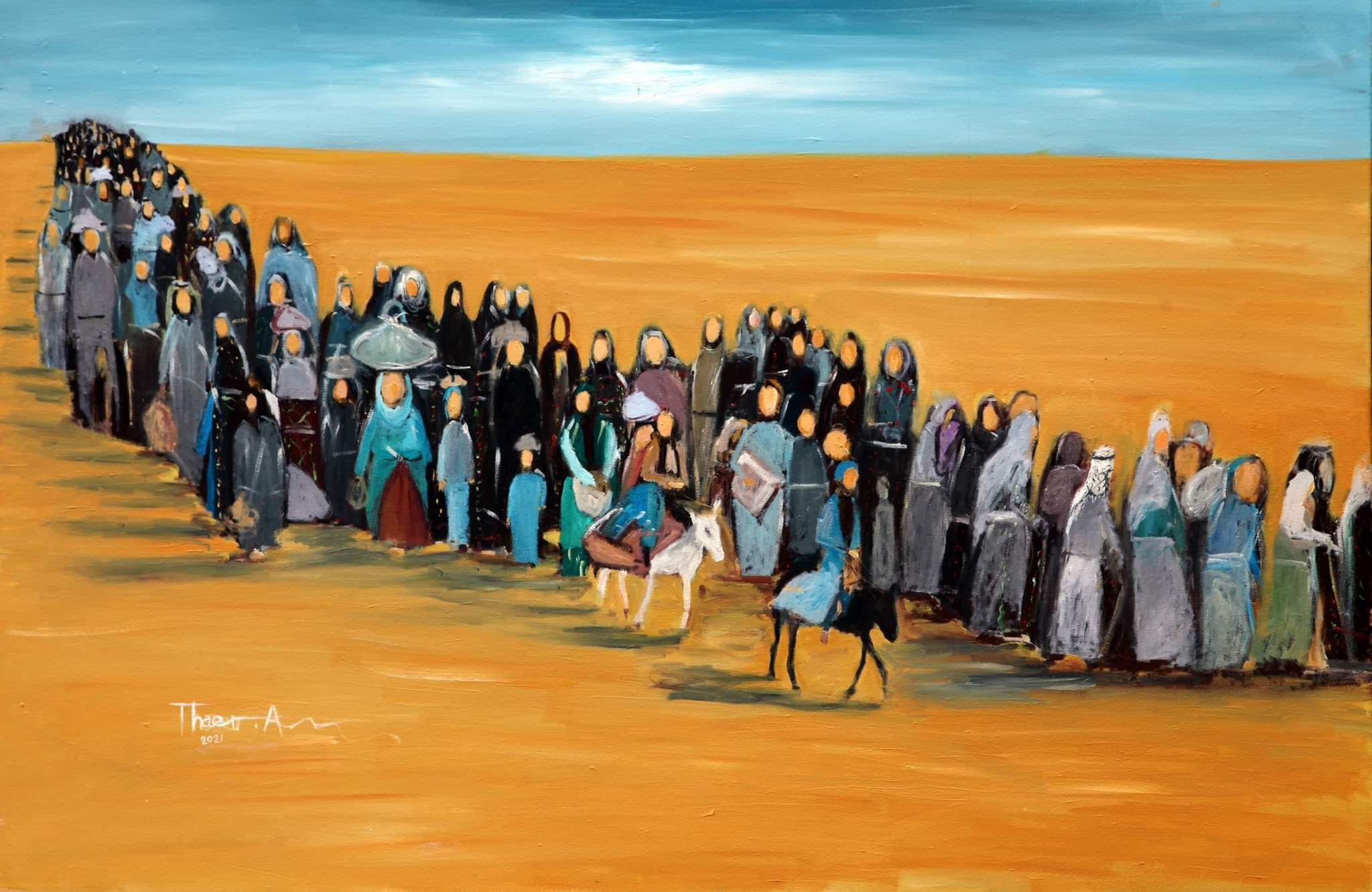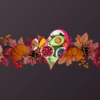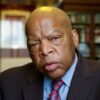written by: Ben Jacques; hbjacques@gmail.com (1,440 words)
Across a yellow canvas, an endless stream of refugees crosses the desert sand. They are the people of “The Nakba,” the catastrophe, Palestinians forced from their homeland 75 years ago this month.
Painted by Thaer Abdallah of Shrewsbury, the 60×40-inch oil painting is on exhibit at the Gallery at Sanctuary in West Medford, along with dozens of art works contributed by immigrants, many of them enrolled in the Immigrant Learning Center in Malden.
For Abdallah, “The Nakba” is family history. His mother was just 11 and father, 15, when they were expelled from Palestine. Allowed to settle in Iraq, although they could not own property, vote, or become citizens, they married and raised 13 children. Thaer was their tenth.
From an early age, Thaer loved to draw. His sketches depicted life in the neighborhood. One sketch shows him and his brother at a window watching “Star Trek” on a neighbor’s television. Another depicts bombs falling on houses. In a painting, a woman plays the violin, while behind her on the boulevard, soldiers stop people and arrest people in traffic.
After the second American war in 2005, Shia militias targeted the Palestinians, evicting them from their homes and inflicting violence. Now 35, Abdallah led five families out of Baghdad, fleeing to the Syrian border. Refused admission, they camped for 40 days and nights in “no man’s land.”
 Thaer recalls the scene in a black-velvet painting–a cluster of tents under a night sky. The sun has set, but there is a lingering swath of orange in the west, and above, almost as if the stars have been smeared, a thin wash of blue. In desolation there is hope.
Thaer recalls the scene in a black-velvet painting–a cluster of tents under a night sky. The sun has set, but there is a lingering swath of orange in the west, and above, almost as if the stars have been smeared, a thin wash of blue. In desolation there is hope.
The artist would later write, “It was one of the best times of my life.” Not least because in this no man’s land, he was able to spend long hours with an American woman he had met. Part of a human rights group called Christian Peacemakers, Sheila Provencher and another American had accompanied the families as they sought safety in Syria. Thaer and Sheila fell in love.
After six weeks at the border, the Palestinian refugees were allowed into Syria and bused to the Al Hol refugee camp in the northern part of the country. Here they continued to petition for permanent resettlement. Because of his communication with embassies and human rights organizations, Abdallah came under suspicion. Accused of spying for the CIA, he was arrested and imprisoned. After one night in a cell, he was taken to an underground room, “where 40 prisoners were crammed together like sardines.”
Abdallah’s drawings record life in the prison. In one, confined in a space too small to stand, a man crouches over in solitary confinement. In another, prisoners are bound against the wall as they are beaten.
In his memoir, “Song in the Desert,” published in 2020, Abdallah recalls: “I was blindfolded and tortured, with beatings on my legs while my feet were immobilized in a truck tire and with ice cold showers with my hands tied behind my back.”
The prisoners were given one boiled egg for breakfast, and one chicken, shared by 40. Prayer and reading the Koran were forbidden. Meanwhile, Sheila worked furiously on his behalf, contacting the United Nations High Commission on Refugees, Amnesty International and other organizations.
After 70 days in prison, Abdallah was abruptly freed and deported back to Iraq, where he found refuge in the Al-Waleed camp. Through the summer he slowly regained his health and courage. He decided to do what he had done before in the camps, give art lessons to the children, using materials Sheila had sent.
After several months, Abdallah left Al-Waleed and returned to Baghdad, where he found a sister and brother. Because it was not safe, he slept each night in a different place, bedding on the rooftop under the stars. While living in Baghdad, he had helped other Palestinians obtain passports that would allow them to flee the country. Now, he too arranged for a passport. He boarded a plane to Istanbul in Turkey.
Three days later, along with others, Abdallah took a bus to the sea town of Marmaris. Here they looked for someone who could take them by boat to Greece. After two unsuccessful attempts, Thaer and 25 other refugees, including a family with three small children, waded into the water and climbed into a motor boat.
An oil painting depicts the sea craft as it heads through choppy waters for the Island of Mytilene. The sun has set and the blue of sky and water, white churning up from the outboard engine, is turning dark. Inside the crowded hull are two dozen refugees in orange lifejackets.
Halfway into the three-hour passage, the boat’s engine stalled and the boat listed from water coming over the sides. The refugees bailed furiously. The smuggler got the engine working again and they continued until, in the dark, he left them on a rocky outcropping 500 meters from the island. It was too far to swim.
Later that night, they were rescued by the Greek coast guard, which took them to Mytilene. Here they were tested for disease and again placed in a camp. Here, too, Abdallah applied for a visa to the United States. Months later, through Sheila’s efforts, Amnesty International and the offices of Senator Edward Kennedy and Congressman Michael Capuano, he was granted a “fiancé visa” to the America.
On April 13, 2008, Thaer Abdallah’s plane touched down in New York. Clearing customs, he was welcomed by Sheila and her father, Paul, who had driven down from Boston to meet him. Delirious with happiness and relief, he rode in Paul’s ‘90s red Volkswagen to the Provencher home in Walpole, where he was welcomed by Sheila’s mother, Mary Ellen. Eight days later, in a mosque in Wayland, Thaer and Sheila were married.
Since his arrival in the United States, while he has learned English, Thaer has worked at a variety of jobs, repairing boats, washing dishes in a restaurant and vacuuming floors at Curry College. He has told his story at organizations in and around Boston. And he has turned again to his canvas, painting people and scenes from the Middle East and America. His first exhibit was held at a Lebanese restaurant in Jamaica Plain. Since then, his paintings have been shown at several galleries.
The year 2012 was momentous. Sheila graduated from Harvard Medical School, a son, Yusef, was born, and Thaer became an American citizen. A few months later, he obtained a visa for his mother, still in a refugee camp. Abdallah flew to Istanbul and accompanied her to Boston. For nine months she lived with them in their Chelsea apartment before succumbing to a stroke. Her funeral was held at the Islamic Society of Boston mosque in Roxbury.
Now living in Shrewsbury, near where Sheila practices medicine, the Abdallahs live a suburban life far from Iraq in distance and culture. Here, however, Thaer is free, and you can often find him at work on his paintings. You might also see Yusef, 11, or Nora, 6, painting at little easels he has set up for them.
Abdallah completed “The Nakba” in time for the 75th anniversary, for the first time commemorated this month by the United Nations. The Nakba was also commemorated by Combatants for Peace, a coalition of Israelis and Palestinians seeking justice and reconciliation.
For Abdallah “The Nakba” is personal. But it is also universal. It compels us to adjust our attitudes about immigrants and asylum seekers. The refugees in the painting could be the masses fleeing violence in Sudan, or the surge of asylum seekers at our southern border.
Likewise, Abdallah’s story is in essence not unlike that of refugees from Haiti, or Vietnam, or El Salvador.
The United Nations estimates there are 117 million displaced and stateless people in the world in 134 countries. Over 29 million are refugees, and 5.6 million are seeking asylum. Wars, environmental disasters, repressive governments and poverty are pushing the numbers up.
But figures are just facts, and if we are to understand the humanity of those who seek a better life among us and their potential to enrich our communities, we must see them as individuals. Abdallah’s art, and the art of other immigrants, exhibited through July 15 at the Gallery at Sanctuary in Medford, can help us do this.
Note: The “IamMigration” community art exhibit runs through July 15 at the Gallery at Sanctuary, 458 High Street in Medford. Readers can find more information at https://sanctuaryucc.org/whats-on/iammigration.





